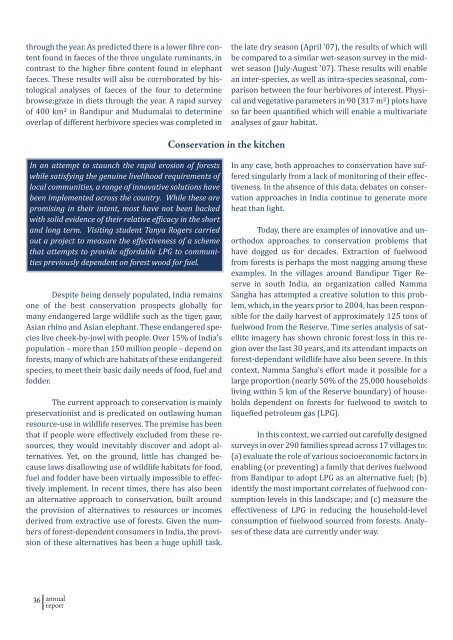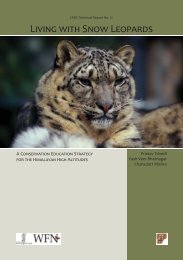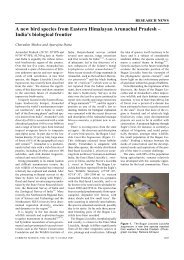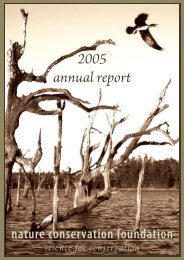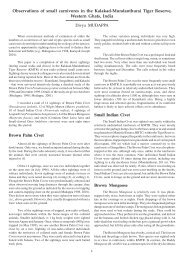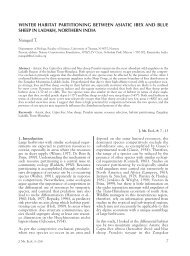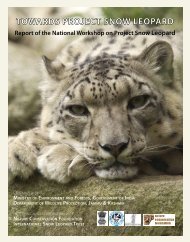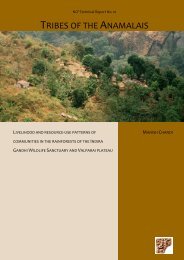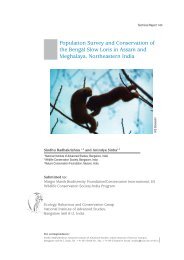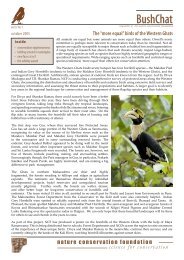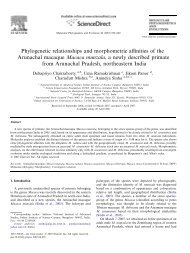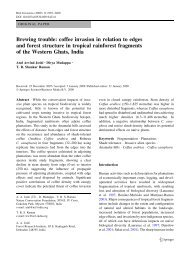2006-7 annual report - Nature Conservation Foundation
2006-7 annual report - Nature Conservation Foundation
2006-7 annual report - Nature Conservation Foundation
Create successful ePaper yourself
Turn your PDF publications into a flip-book with our unique Google optimized e-Paper software.
through the year. As predicted there is a lower fibre content<br />
found in faeces of the three ungulate ruminants, in<br />
contrast to the higher fibre content found in elephant<br />
faeces. These results will also be corroborated by histological<br />
analyses of faeces of the four to determine<br />
browse:graze in diets through the year. A rapid survey<br />
of 400 km2 in Bandipur and Mudumalai to determine<br />
overlap of different herbivore species was completed in<br />
the late dry season (April ’07), the results of which will<br />
be compared to a similar wet-season survey in the midwet<br />
season (July-August ’07). These results will enable<br />
an inter-species, as well as intra-species seasonal, comparison<br />
between the four herbivores of interest. Physical<br />
and vegetative parameters in 90 (317 m2) plots have<br />
so far been quantified which will enable a multivariate<br />
analyses of gaur habitat.<br />
<strong>Conservation</strong> in the kitchen<br />
In an attempt to staunch the rapid erosion of forests<br />
while satisfying the genuine livelihood requirements of<br />
local communities, a range of innovative solutions have<br />
been implemented across the country. While these are<br />
promising in their intent, most have not been backed<br />
with solid evidence of their relative efficacy in the short<br />
and long term. Visiting student Tanya Rogers carried<br />
out a project to measure the effectiveness of a scheme<br />
that attempts to provide affordable LPG to communities<br />
previously dependent on forest wood for fuel.<br />
Despite being densely populated, India remains<br />
one of the best conservation prospects globally for<br />
many endangered large wildlife such as the tiger, gaur,<br />
Asian rhino and Asian elephant. These endangered species<br />
live cheek-by-jowl with people. Over 15% of India’s<br />
population – more than 150 million people – depend on<br />
forests, many of which are habitats of these endangered<br />
species, to meet their basic daily needs of food, fuel and<br />
fodder.<br />
The current approach to conservation is mainly<br />
preservationist and is predicated on outlawing human<br />
resource-use in wildlife reserves. The premise has been<br />
that if people were effectively excluded from these resources,<br />
they would inevitably discover and adopt alternatives.<br />
Yet, on the ground, little has changed because<br />
laws disallowing use of wildlife habitats for food,<br />
fuel and fodder have been virtually impossible to effectively<br />
implement. In recent times, there has also been<br />
an alternative approach to conservation, built around<br />
the provision of alternatives to resources or incomes<br />
derived from extractive use of forests. Given the numbers<br />
of forest-dependent consumers in India, the provision<br />
of these alternatives has been a huge uphill task.<br />
In any case, both approaches to conservation have suffered<br />
singularly from a lack of monitoring of their effectiveness.<br />
In the absence of this data, debates on conservation<br />
approaches in India continue to generate more<br />
heat than light.<br />
Today, there are examples of innovative and unorthodox<br />
approaches to conservation problems that<br />
have dogged us for decades. Extraction of fuelwood<br />
from forests is perhaps the most nagging among these<br />
examples. In the villages around Bandipur Tiger Reserve<br />
in south India, an organization called Namma<br />
Sangha has attempted a creative solution to this problem,<br />
which, in the years prior to 2004, has been responsible<br />
for the daily harvest of approximately 125 tons of<br />
fuelwood from the Reserve. Time series analysis of satellite<br />
imagery has shown chronic forest loss in this region<br />
over the last 30 years, and its attendant impacts on<br />
forest-dependant wildlife have also been severe. In this<br />
context, Namma Sangha’s effort made it possible for a<br />
large proportion (nearly 50% of the 25,000 households<br />
living within 5 km of the Reserve boundary) of households<br />
dependent on forests for fuelwood to switch to<br />
liquefied petroleum gas (LPG).<br />
In this context, we carried out carefully designed<br />
surveys in over 290 families spread across 17 villages to:<br />
(a) evaluate the role of various socioeconomic factors in<br />
enabling (or preventing) a family that derives fuelwood<br />
from Bandipur to adopt LPG as an alternative fuel; (b)<br />
identify the most important correlates of fuelwood consumption<br />
levels in this landscape; and (c) measure the<br />
effectiveness of LPG in reducing the household-level<br />
consumption of fuelwood sourced from forests. Analyses<br />
of these data are currently under way.<br />
36<br />
<strong>annual</strong><br />
<strong>report</strong>


